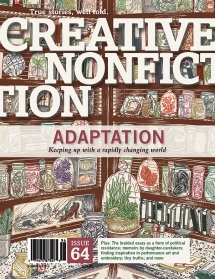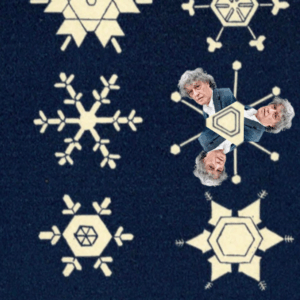
What Quilting and Embroidery Can Teach us About Narrative Form
"Stitches Might Help Writers Break from the Traditions of Built Texts"
Many more times a day than I believe to be normal, I will catch something falling from my desk, mid-air.
In my hand will be an object that I myself just knocked over the edge—a teacup, a pair of scissors, a can of bright pens. And in the moments immediately after making the catch, I’ll be flooded with a memory that I had otherwise lost, a snapshot of my life from a very different place and time, when I opened my elbow and snatched something out of the air. I’ve been making this motion all my life. My right arm throws something to my left.
A neurologist could probably explain both my rampant clumsiness and the relationship between reflex and synapse that sends the mind zinging haphazardly through time from one saved mug to another. But as a nonfiction writer, this snatching of lost memories reminds me that the narratives we live inside are never linear from the start. Our stories are patterns of experiences, a few knit together and the vast remainder discarded as scrap.
The idea of human memory as a folded or patchwork process is familiar to those who read and write braided essays. Each narrative “thread” in a literary braid interrupts other narratives in a pattern that recalls the winding of three strings. In a braided essay, the reader can visit the past and future alternately, skipping across time and space as if following the path through a distracted mind. But the real beauty of a successful braid is how the “threads” combine thematically to form a more complete and pliable piece of nonfiction. A literary braid also makes the quiet argument that all stories are perhaps bound this way, in handfuls that don’t abide by chronological time. For me, the braided form is also dropping hints that some stories can only be written this way.
Of course, this type of thinking goes against what most of us learned, at small, kidney-shaped desks, about how good writing is built from the ground up, like a skyscraper. Now that I find myself at the front of classrooms much more often than in desks, I’m surprised to see how writers of all levels feel compelled to follow those linear blueprints that our first English teachers passed on, often to the detriment of their creative work.
In a recent article in the LSE Review of Books, the writer Katie Collins describes how writers in the social sciences often use the language of buildings to describe a piece of writing. Arguments must have “frameworks and foundations” or they might be “shaky and even fall down.” Collins says that academics use this language to bring a sense of order and rationality to their naturally rambling thoughts. Lately though, I’ve noticed that the language of text-as-building is also permeating my writing groups and nonfiction classrooms. In workshop, we tell each other that narratives “might need to be shored up with facts,” that an essay “could be buttressed with scene,” or even that a memoir might use “a stronger foundation through backstory.” (My italics.) So it seems that we creative writers, too, are comforted in thinking that, like a new hotel, our progress is moving in a straight line, from one floor to the next, in a shape that is already recognizable to the public. But what if in forcing our stories into a linear, sequential form, we risk oversimplifying the richness of human experience?
When I was ten, I was gifted a book called Subversive Stitches. I went straight to my mother’s dictionary, which stood on a literal pedestal beside her desk, to figure out what subversive meant. Afterwards, fanning the pages of my new crafting book—full of patterns for embroidering shoes and cats and the phrase Girl Power! with daisies in the O—I thought I had misunderstood the definition. But it turns out that stitching does, in fact, have a long history of subversion. And lately, because embroidery hoops and balls of wool are falling from my desktop as often as pens and pencils, I’ve been thinking about how stitches might help writers break from the traditions of built texts. Talking about texts in terms of thread pushes the braided essay further in favor of other nonlinear and decentered models of creative nonfiction—forms that seem exceptionally relevant today.
“What if in forcing our stories into a linear, sequential form, we risk oversimplifying the richness of human experience?”
Quilted Essays
Quilting is best known as a domestic art, but traditional quilts follow deeply coded patterns that communicate much more than comfort and artistry. A quilt’s surface can often be “read” through linguistic and graphic cues. In many cultures, quilts act as historical documents that preserve narratives about place and identity. The scholar Mara Witzling writes that quilts historically “enabled women to speak the truth about their lives” by joining many disparate fragments, which when read together make a specific and often subversive “utterance.” In 19th century America, quilts made many different utterances: they could transmit a local history, recount one version of a family feud, or physically connect living women to their ancestors by combining inherited fabrics. Before women’s suffrage arrived, American women also made quilts to express their political sentiments. Many examples of political quilts, like those credited with securing the presidency for William McKinley, joined campaign ribbons with fabric and other text-based materials. These quilts gave a voice to women who could not yet legally submit their votes.
Like every quilt I’ve started but never finished, many traditional quilted patterns begin in the middle. First, the quilter chooses the centerpiece and, then, works outward, attaching sections of fabric with even stitches as the blanket begins to expand. Colors, textures, and weights are joined gradually to develop a composite image. Quilters call this process “piecing.” As a material metaphor for nonfiction, writers interested in new forms might consider “piecing” sections of text as a means of working outwards from a kind of center. This center could be the most significant or challenging moment in an essay. From there, the process of “piecing” a text, rather than writing it in a straight line, could free the writer from concerns about repetition, foundations, and chronology. In a quilted essay, a newspaper headline might fall beside a personal scene, and beside other diverse materials that build gradually toward a larger complex “utterance.” To talk about a quilted text, we writers might admire the variety and contrast of the materials an author chooses or the way a writer situates sections carefully, in conversation, so we readers can still keep our eyes on the center.
Stitching a Scene
Historically, embroidered pieces like tapestries and applique samplers have recorded the types of personal narratives that were never saved on paper. One display at the new African American History Museum in Washington, DC, features Ashley’s Sack, a cotton bag from 1851, which originally carried a dress, three handfuls of pecans, and a lock of hair—a mother’s gift to her nine-year-old daughter, who was sold away from her. In 1921, the daughter’s granddaughter, Ruth Middleton, embroidered fifty-two words into the sack, the story of three generations of women experiencing slavery. She used pink floss to embroider the sack’s central line: It be filled with my love always. It is the brevity of this text—limited by the medium that Middleton used—that leaves us the space to understand the fracturing of this family and the limited ways that many people have to pass along their own histories. Ashley’s Sack also reveals how, in many cases, significant narratives could only be told through nonlinear structures and were preserved only because they were attached to utilitarian objects or because they were decorative.
Embroidery is a decorative technique that combines two materials. If you want to start embroidering, you’ll need something called floss—a material richer in color and more texturized than sewing thread. Floss is designed to get noticed. An artist chooses a floss that will bring out the subtle characteristics of the fabric below without letting its color or texture overwhelm.
Floss is made from fibers, just like the fabric it details. We might consider the literary equivalents of floss to be the rich and often brief lines of a memoir that we pause over—the lines that shine because they appear in small patches that might overwhelm the piece if overdone—and writers might also learn from embroidery how to massage a revealing description into a hard knot of facts.
When crafted tactfully, a beautifully described personal scene, like a stitched text, can reveal the complex layers that compose a larger narrative. Today, artist Gina Adams, who traces her heritage to both indigenous and colonial Americans, embroiders text from broken American Indian treaties onto vintage American quilts. “I’ve always had these two sides within me,” says Adams, who stitches in protest of the more than 370 Native treaties broken by the U.S. government and as a way to communicate the duality of her heritage. “My work,” she adds, “is both a political statement and an apology.” From Adams’s stitching, we can also see that writing the truest version of a story is often a process of unifying disparate and sometimes contradictory materials.
“A beautifully described personal scene, like a stitched text, can reveal the complex layers that compose a larger narrative.”
A Knitting Trick for Beginnings and Endings
As threaded structures go, knitting has always gotten the worst rap. In an 1850 Currier & Ives lithograph, The Life & Age of Woman. Stages of Woman’s Life from the Cradle to the Grave, the final figure is a hundred-year-old grandmother who “listless knits ’till death appears,” according to the caption underlining her image. Culturally, knitting is the practice women take up when they have nothing left to do, but new research says that taking up knitting, like starting Sudoku or a crossword ritual, sharpens and hones the mind. Finnish school children learn to knit before they learn to read. Many progressive education models suggest that early knitting helps link the left and right hemispheres of the brain and supports children in learning the alphabet. By third grade, in Finland, the kids switch to crochet, which compliments the students’ first lessons in math and reading. Studies suggest that knitting can relieve symptoms of depression and anxiety, and slow the progress of cognitive diseases. Albert Einstein knitted; so does Christopher Walken.
“You could say that my writing isn’t quite right. That all the beginnings have endings in them,” writes Lidia Yuknavitch in her essay “Woven.”
For a knit object to appear to be made of one continuous piece of yarn, the artist has to hide the loose ends. This technique, which is especially useful in finishing a sleeve or an infinity scarf, is called “weaving the ends back into the body.”
As a reader of nonfiction, one of the sensations I’m always coming back for is that feeling, at the end of a piece, of wanting to start again. I relish revisiting openings that seem like they were preparing me for the conclusion from the start. If writers thought more often, as knitters do, about hiding their ends in their beginnings, they might find more useful ways of troubleshooting both techniques. Someday, when I’m really stuck, I might end up thinking to myself, “This opening feels lumpy. I’ll try weaving in my ends.”
Piecing an essay, embroidering a scene, knitting the end to the beginning: what I mean in championing more threaded literary forms is not a kind of relativism about truth or chronology in nonfiction. Zadie Smith, whom I think of as a writer who hides essays in her novels, writes, “Time travel is a discretionary art: a pleasure trip for some and a horror story for others.” Words and their forms carry the weight of ideologies. If we talk about writing using only the language of buildings, we suggest that stories of all kinds need to live in these rigid, singular forms—forms that historically didn’t preserve many kinds of narratives, forms that even render some true stories unrecognizable. So the notion that nonfiction could be non-linear for a reason is not purely an aesthetic claim. “What did it mean for a black woman to be an artist in our grandmother’s time?” asks Alice Walker. “It is a question with an answer cruel enough to stop the blood.” Some stories, I argue, have been and can only be written in other ways. Zadie Smith argues that progress of any kind is not linear. If we know our personal and cultural history, we can never arrive at the end of an essay, or an era, thinking, Yes—finished with that topic now. We cannot go forward imagining that we will keep moving without ever revisiting our lessons. If we forget this, we are at risk of sliding back to those horrors. On the contrary, what I hope to suggest is that threaded, decentered forms of nonfiction enact this practice of revival, of glancing back as a means of propulsion. Where thread and memory are related, “subversion” means that threaded objects have allowed many voices to adapt to restrictive environments. These forms also reveal that not all true stories have been visible or lived in straight lines.
In her lectures, visual and textile artist Anne Hamilton has suggested that tapestries inherently recall collaboration and interconnectedness in the way that the story of a family, or of a nation, is in fact made of many individual stories that link and inform the others. For me, threaded literary forms also suggest that minds, like communities, move not from one logical point onward but rather in conversation with our histories and our many, many selves—forever pushing against what has happened and into what is happening next.
For Further Reading: Nonfiction Inhabiting or About Threaded Forms
Susan Griffin, “Red Shoes”
Griffin alternates personal and academic nonfiction styles to develop a meditation on the color red, on fabric, on intimacy, and on the ways we write about bodily experiences both in and outside of the academy.
Gretchen Henderson and Allison Dalton, “Unstitched States”
This ongoing collaborative project, which came together through a process much like a quilting circle or quilting bee, unites hybrid texts by artists who were asked to respond to the outcome of the 2016 elections. Henderson, who previously headed the Kenyon Review Hybrid Book Arts Workshop, calls it “a testament of solidarity to the principles of equality and dignity.”
Christine Wilks, “Fitting the Pattern or being a dressmaker’s daughter: a memoir in pieces”
This interactive essay takes the form of a dress pattern and interrogates the space between text and textile. Wilks, whose mother was a dressmaker, asks her audience to bring their own interpretations to the process of reading and storytelling as they “stitch together” the literal pieces of her narrative on screen.
Lidia Yuknavitch, “Woven”
This essay interweaves personal stories of childhood, birth, and personal abuse with myths about water spirits to consider how narratives of physical trauma can and have always been told.
Rachel May, Quilting With a Modern Slant
In this book, May grounds readers in the history of quilting and its traditional techniques while telling the stories of seventy young quilters who are using innovative patterns to build modern quilted narratives.
__________________________________

This essay originally appears in Creative Nonfiction Issue #64, Adaptation.
Sarah Minor
Sarah Minor is a writer and a designer from Iowa. She edits the “Visual Essays” series at Essay Daily and is working on a series of hybrid essays made of both text and thread. This fall she will begin teaching as an assistant professor of nonfiction at the Cleveland Institute of Art.



















